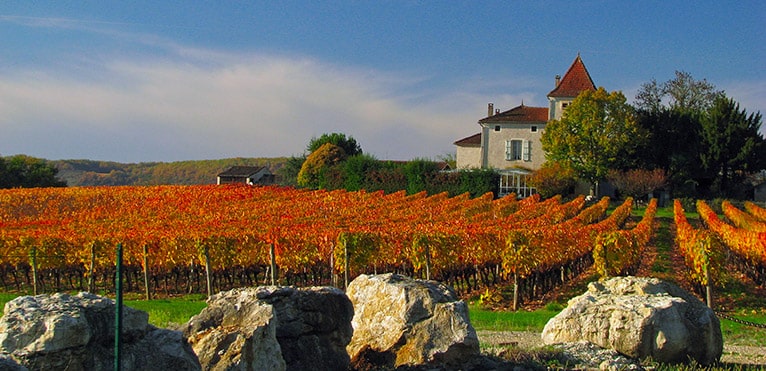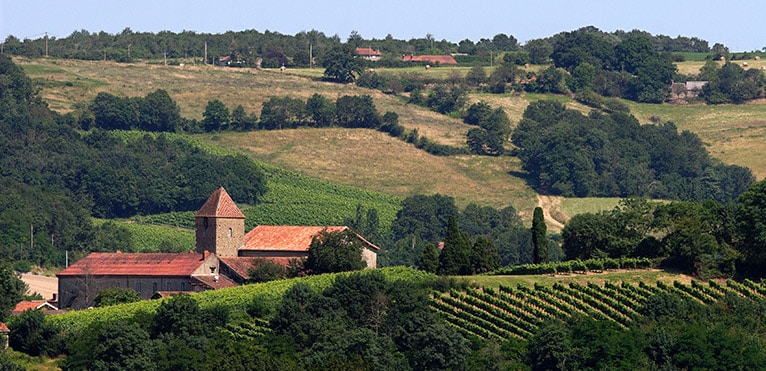The vineyards of the Sud-Ouest region are among the oldest in France, along with those of Provence. They cover the 5 historic provinces of Béarn, Aquitaine, Guyenne, Basque Country, Rouergue and Gascogne. South-Western wines benefit from a climate that is particularly influenced by oceanic air and Mediterranean sunshine, which favors a high degree of exposure.
With vineyards stretching from the south of the Massif Central to the Pyrenees, and from the Basque country to the Aveyron, the region boasts a vast wine-growing reserve, thanks in particular to its wide range of grape varieties.
The region is renowned for its 30 AOC appellations. Wine production is mainly composed of red and rosé wines (80% of regional production), with white wines accounting for the remainder.
The history of Southwestern wines
The cradle of regional viticulture is in the Tarn. In IVth century century BC, historians have proven that Celtic populations occupied the South of the Massif Central. At Montans, in the Gaillac region, vinous ceramics have been found dating back to 200BC. Trade with Italy already existed at the time, but the wine was of poor quality, and pottery was the mainstay of the trade.

In 200 BC, the Romans gradually took control of the region, opening up new river trade routes. As worthy heirs of the Greeks, the Romans intensified the cultivation of their land. wine and trade throughout the South-West region. They planted the first vines in the vineyards now known as Cahors, Bergerac and Jurançon. Some of these wines are then exported via the Cahors – Bordeaux river route, first to Bordeaux. Later, the Tarn became a major trade route, with barrels of wine being shipped to Brittany and the British Isles. It should be noted that the first wines consumed in the Bordeaux region were Gaillac wines, as the famous Bordeaux wine production had not yet developed at that time. The jars and ceramics found along the region’s river routes attest to a high level of traffic commercial important.
The fall of the Roman Empire to the barbarian invasions brought the regional wine trade to a halt, and the vines were destroyed. The entire region came under Visigoth control. It was the Christian monks who made it possible for French wine to survive by once again exploiting the wine-growing terroirs to produce their vin de messe. Some wines, such as Jurançon and Madiran, have made a name for themselves thanks to pilgrims to Santiago de Compostela, for example.
In the 15th and 16th centuries, numerous writings mention wines from the South-West. Rabelais praised the dry white Bergerac in particular, praising its “suave sweetness”. The region’s reputation grew with the creation in 1529 of a competition for the best Gaillacois winegrower. Legend also has it that Henri IV was baptized in Jurançon, a wine he later regularly invited to his table as a ceremonial wine.
In the 17th century, the apogee of Dutch commercial power transformed the regional wine market. At the time, the Dutch had a pronounced taste for sweet and syrupy wines. This benefits Monbazillac and Jurançon wines, which are exported on a massive scale to the Rhine axis.
In the second half of the 19th century, parasites such as powdery mildew and phylloxera ravaged the vines. The inter-war years saw the birth of the first AOCs in 1936, notably for certain Bergerac wines. Since then, some 30 appellations d’origine contrôlées have made the region famous.
The terroir of the South-West is based on a singular geography
With over 55,000 hectares of vineyards, the region boasts an extremely varied wine-growing landscape. Bergerac’s hillsides are home to vineyards, and along the Dordogne river are the “sables du Périgord”. Cahors vines are planted on terraces on the left bank of the Lot. To the south-east, Gaillac’s vineyards stretch along both banks of the Tarn, with hillsides, terraces and a plateau. The Fronton vineyards are located on the left bank of the Tarn, north of Toulouse. The Madiran vineyards are located at the foot of the Pyrenees, on the hills on the left bank of the Adour river. Even further south, the vineyards of Jurançon also lie at the foot of the Pyrenees, between the valleys of the Gave d’Oloron and the Gave de Pau. The Irouleguy appellation is produced on Basque soil, the closest vineyard to the Atlantic. The vineyards are located on hills reaching up to 800 meters in altitude (Pic de Jara).
The region’s rich terroir also offers great diversity in soil composition. At the foot of the vineyards, you’ll find sandy and limestone soils, clay-enriched soils (for good water retention), silica soils (mainly around the Massif Central), alluvial soils along the Dordogne and iron-enriched red clays.
The climate is obviously one of the region’s major assets. The sunshine in the South-West is particularly favorable to good vine growth. The climate is oceanic, i.e. mild and humid. This climate is accompanied by Mediterranean and mountain influences from the Massif Central and the Pyrenees. The traditional climatic pattern of the South-West sees late spring frosts, cold winters and warmer summers and autumns every year. Beyond this general climate, each appellation also boasts its own microclimate, which helps to justify its own identity. Regional sweet wines, for example, are made from grapes affected by the botrytis cinerea fungus, which causes “noble rot” on the grapes. This fungus thrives thanks to the presence of numerous waterways and forests, which favor the creation of morning mists. It’s then the sunny autumn afternoons that allow “noble rot” to appear. Lastly, the region is crossed by windy currents in the southern vineyards, in particular hot, dry air that blows over the southernmost vineyards mainly in autumn and spring.
South-West grape varieties
One of the distinctive features of South-Western vineyards is the wide variety of grape varieties used to make their wines. Red wines are produced from 300 different grape varieties, 120 of which are indigenous. The wines of the South-West therefore include both world-famous grape varieties and indigenous varieties such as Négrette or Duras. The following grape varieties can therefore be found in wines from the South-West, a non-exhaustive list that bears witness to the region’s rich winemaking heritage.
Cabernet-Sauvignon
Cabernet-Sauvignon is undoubtedly the most famous grape variety used in the blending of the Médoc’s grands crus. The blue color of the grapes lends a certain density to the wine. The higher the proportion of Cabernet-Sauvignon, the more pronounced the notes of blackcurrant and copper.
Malbec
This grape variety is the mainstay of Cahors production. Also known as “Cot” or “Auxerrois”, this grape variety is native to the South-West of France. It gives the wine a full-bodied character with powerful tannins.
Duras
Native to the Tarn region, this grape variety is a key component of Gaillac appellation wines. One of its particularities is its higher alcohol content than other grape varieties.
Merlot
Traditionally used to make Bordeaux wines, Merlot adds roundness to Southwestern wines.
Cabernet Franc
This grape variety originated in the Southwest of France, and is often blended with Cabernet-Sauvignon and Merlot. In a blended wine, it brings balance and soft tannins.
Negrette
This grape variety is one of the oldest in the South-West region. In a wine, it brings pronounced aromas and intense violet fruitiness. It is notably found in Fronton wines.
Tannat
The grape variety behind the Madiran appellation, Tannat brings a high concentration of tannins to the wine. It brings a certain balance to the fruity side.
Gros Manseng
This grape variety probably originated in the Pyrenean Piedmont, and is found in a number of wines from the South-West, including Pacherenc, Jurançon and Tursan.
Mauzac
Mainly grown in the Gaillac vineyards, Mauzac is a grape variety that produces full-bodied white wines with aromas of apple, honey and vanilla.
Chenin
Originally from the Loire region, this this variety in Southwestern wines. It brings liveliness to wines, and in terms of aroma, notes of citrus fruit, spices and honey can be found.
Colombard
This variety of grape comes from Gascony and gives wines a lively, fruity character. It is mainly used in the blending of Côtes-de-Gascogne appellation wines. In proportion to its concentration, we detect more or less exotic fruit aromas.
The most famous AOCs in the South-West
AOC Monbazillac
Monbazillac is an appellation in southwestern France. Composed exclusively of white wines, it is the world’s leading sweet wine-producing appellation. She is established on the 5 communes of Monbazillac, Saint-Laurent-des-Vignes, Rouffignac de Sigoulès, Colombier and Pomport. Monbazillac stands out thanks to its AOC label obtained in 1936. Monbazillac wines are world-renowned for their power combined with intense sweetness, and the roasted note in the aromas is also one of the defining characteristics of this South-Western wine.
AOC Cahors
Visit Cahors is a world-famous wine appellation. Production takes place along the meandering Lot river in the piedmont of the Massif Central. It stretches from east to west over 60 kilometers from Cahors to Soturac. Le Cahors is only available in red wine, and is produced from Malbec, Merlot and Tannat grapes. Its distinctive color, ranging from purplish-black to purple, has earned it the nickname “Black Wine”.
Madiran AOC
Exclusively composed of powerful red wines, Madiran is produced near the Adour river in the Aquitaine basin, in the departments of of Gers, Pyrénées-Atlantiques and Hautes-Pyrénées. Its 1300-hectare vineyard overlaps with that of Pacherenc du Vic-Bihl. A dark ruby-black wine. It is composed of at least 50% Tannat, the king of Madiran grapes.
AOC Fronton
Fronton is more commonly known as “the wine of the Toulousans” for its proximity to the pink city. It is produced around the town of Fronton, in the western Piedmont of the Massif Central and 30 km north of Toulouse. The appellation covers 2300 hectares, producing outstanding red and rosé wines. These are produced from various blends of the following grape varieties: Négrette (a local variety found in Gaillac), Syrah, Cot, Cabernet Franc, Cabernet-Sauvignon, Fer-Servadou and Gamay.
AOC Buzet
Buzet is an appellation in the Agen region. Its vineyards are bounded by the Garonne River to the north and east, and by the Landes forest to the west. The vineyard produces red, white and rosé wines. In red, wine is produced from Cabernet Sauvignon, Merlot and Cabernet Franc. For white wines, the following grape varieties are used: Sauvignon, Muscadelle and Semillon.
Jurançon AOC
Jurançon is a wine produced in the Béarn region. The vineyards are mainly planted focused on dry and sweet white wines. Jurançon is world-famous for its intense golden color. Spice and honey aromas combine with power to produce a delicate, very fruity wine.
Discover all the wine regions
Contents
Production
320 million bottles
Surface
50,000 ha
Soil and subsoil
clay-limestone, boulbène, pebbles, clays, sand-fauves and sandstone limestone
Red grape varieties
Cabernet-Franc, Cabernet-Sauvignon, Malbec, Duras, Fer-Servadou, Gamay, Merlot, Négrette, Punelard, Syrah and Tannat
White grape varieties
Arrufiac, Baroque, Chenin, Colombard, Courbu Blanc & Petit courbu, Gros Manseng, Loin de l’œil, Mauzac, Ondenc, Petit Manseng and Sauvignon-Blanc
Southwestern wine : les vins les mieux notés sur Twil
Je découvreSouthwestern wine : les vins sélectionnés par Parker
Je découvreMain grape varieties of South-West wines
Popular South-Western appellations
- Bergerac, Southwestern wine
- Côtes-de-Bergerac, Southwestern wine
- Fronton, Southwestern wine
- Jurançon late harvest
- Monbazillac, White wine from South-West France



